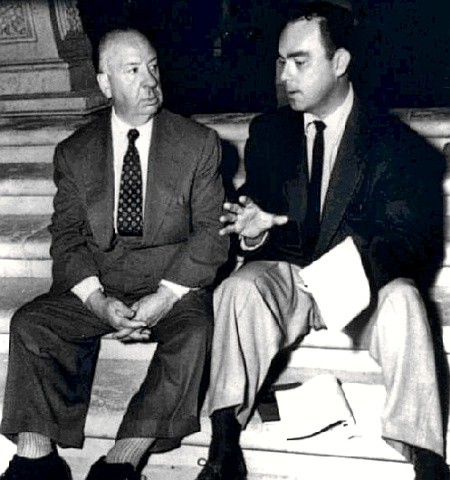

Interview with REAR WINDOW Scribe John Michael Hayes
Interview Archive Series, 2004
August 1st, 2020
by Christopher Wehner
This is an interview I was really happy to get back in 2004, it was a pleasure to interview such a screenwriting legend as John Michael Hayes. We have also added a neat short interview with him where he discusses characters and Hitchcock.
Rear Window is considered to be Hitchcock's most "cinematic" picture. At times it had to communicate a lot to the audience without a word ever being spoken. This isn't surprising as Hitchcock started directing in 1922, during the silent era, making several silent films. By 1954, the year Rear Window was released he had clearly mastered the art of directing. However, before he could unleash his visual brilliance there had to be a great script from which to allow such a great movie to be made.
Think of the drawbacks to the story. First, the protagonist is bound to a wheelchair and is most of the time a reactive participant who is essentially isolated. Second, the antagonist doesn't say more than a dozen words (at least that we hear), and isn't confrontational with the protagonist until the very end. Hitchcock often said, "the better the villain, the better the picture." The obstacles placed in the protagonist's way were rooted in circumstance and happenstance-nothing placed by the antagonist. Thirdly, the entire movie takes place in an apartment and what is seen from the window. What might at first be seen as limitations were most likely viewed as cinematic possibilities and challenges that Hitchcock could not refuse.
John Michael Hayes' screenplay was based on Cornell Woolrich's original 1942 short story "It Had to Be Murder". He was assigned to write the script after one meeting with Hitchcock.
Hitchcock didn't sign on to direct the picture until after reading a thirteen page treatment by playwright Joshua Logan. Logan's work laid the foundation from which Hayes wrote his treatment.

The short story lacked several important details which were added to the screenplay. It did not have a strong female character, or love interest, and Logan keenly injected that into the narrative. But, for the most part, it stuck closely to the source material. Logan's treatment opens with New York City and Jefferies (the name is spelled "Jeffries" in Woolrich's story and Logan's treatment), who's isolated in his apartment due to a broken leg in a cast. Logan created Trink, a love interest for Jeff, who is later renamed Lisa by Hayes. Also, in Logan's treatment, Jeff is a sports writer, which is later changed to a photographer by Hayes. As in the final movie, Logan's treatment has Jeff's love interest go into the killer's (Thorwald) apartment where she is discovered. The killer later comes after Jefferies when he is alone. But before he can kill Jefferies he is himself killed. Which, of course, was changed by Hayes.
Logan's treatment clearly laid the foundation for Hayes to build on, but it had several problems and lacked numerous elements that Hitchcock and Hayes would add to strengthen the story: story elements, richer characters, more conflict, and better visuals.
Hayes constructed a convincing narrative with richly drawn characters and keenly raised the emotion and drama by injecting well placed conflict. Hayes knew that everything hinged on Jefferies' character. He had to build a sympathetic protagonist the audience would absolutely love spending time with in order for the movie to work. He fleshed out Jefferies' background, his relationship with Lisa, and his own internal conflict and emotional resolve. The result is a classic Thriller.
Tell me about your first meeting with Hitchcock. I was given a copy of the Woolrich story by my agent, and was told to meet with Hitchcock later that week for dinner at the Beverly Hills Hotel. My job was simple: Read the Woolrich piece, and be prepared to discuss it in great detail and length. It was not unlike preparing for the most important book report of one's life.
The meeting itself was a near fiasco. It felt much more like a personal test of endurance than anything resembling a story conference. Hitchcock arrived late and, with time to sit and worry over his arrival, I had a couple of drinks, which I wasn't entirely used to. Upon his arrival, we had a feast for the ages, along with copious amounts of alcohol.
Plied by the liquor, I rambled on for much too long about Hitchcock's prior films. And I wasn't entirely complimentary. Hitchcock appeared to listen, but once the meal itself was finished he abruptly left. And we had never even spoken about Rear Window at all. Later, after returning home, my wife asked how the meeting went. I told her we'd better start packing our bags, as I felt quite strongly that my opportunity with Hitchcock had vanished along with any future career I had envisioned in the industry.
Amazingly, upon reporting for work on Monday, I was told that Hitchcock immensely enjoyed our dinner and that I was to be hired immediately.
When you started working on a story in outline or treatment form, did you start with characterizations, plot, situations, structure, or what? In crafting any story, you need to go into it holding dearly a clear understanding of where it is you want to end up. If you delve into a script with no clear concept of how you want it to end, you'll flounder while looking for ways out of the problems you've brought upon your own script. In other words, any lack of direction in regards to your ending directly affects the entire script itself. You'll spend days trying to re-vamp problems you've created by not having a clear direction from the get-go.
In Rear Window there isn't your typical strong villain and the protagonist is bound to a wheelchair, so how difficult was it to maintain a level of tension and suspense? Having non-typical characters was of no real hindrance to the establishment of tension and suspense. In reality, there was a lot to work with. With a non-typical villain, you had the built-in opportunity to engage the characters in a "It couldn't be him. Could it? He's just a regular fellow" form of banter, just as much as having the protagonist limited in his physical actions helped the suspense of, "How in the world is he going to defend himself, if need be?" Writers sometimes habitually overdo it in how their characters move, act, and depict themselves. Grand flourish in a villain works for Bond movies, I suppose, but, in the world you and I live in, true villains don't act as such. At least not on any level you or I may have experienced. There's a form of everyday villainy that is largely forgotten now in cinema. And that's what audiences can align best with-what it is they see and know in everyday life.
You really fleshed out Cornell Woolrich's short story by adding the love story and fully developing Jefferies' character, among other things, which were not in the book. Was this your idea or Hitchcock's? The idea of adding the Fremont character was mine, and it was based upon my wife, Mel, who was in fact a high fashion model herself. The love interest is a requirement, or at least it was at the time and place in which the story was crafted. My opinion was, and still is, that we all fall very hard in love sooner or later, and can clearly relate to the concept of peril brought upon those that we strongly care about. As well as the simple fact that having a headstrong, yet imperiled, female character could add a great bounty to the story. As for Jefferies, it was necessary simply due to the relative brevity of the original work. That much was clearly visible by all from the beginning of the project.
While you were writing the treatment and script for Rear Window, how involved was Hitchcock? Early on he was still working on Dial M for Murder. One of the greatest assets of working with Hitchcock was that he essentially left you, the writer, alone to do your work. Once I completed the work expected of me, Hitchcock and I would then literally pore over the material almost shot by shot. That was primarily his biggest involvement at that stage of development-after I had completed the first expectations of my task. Unlike a lot of other directors and producers, he didn't bother you constantly for pages in order to summarily reject them.
What were the best and worst things about working with Hitchcock? The best part of working with Hitchcock was the autonomy to do the job you were hired to do without interference, as I've mentioned above. The worst part was his distinct stinginess in being able to offer credit where credit was due. It was of paramount importance for him to be seen as a one-man show, but that just simply wasn't the truth, at least not in my experience.
Looking back on how the two of you parted ways, what do you suppose it was? What it was is exceptionally simple: He wasn't for a moment willing to allow anyone to believe he couldn't do it all on his own. I believe in application of credit where credit is due-if you've earned it, you need to be respected, regarded, and properly credited for it. At times in our work together, Hitchcock wasn't willing to allow that.
If you could only chose one, which film of yours best represents you as a screenwriter? Any writer's career is a work in progress. You're always trying to best yourself, and are almost always convinced that your boldest and newest advancement as a writer is naturally your best work. It would be of exceptional difficulty to select one film of mine over another. In my opinion, and in hindsight, they all have their own strengths and weaknesses. What I've always tried to do-what I've always wanted to do-is to tell big stories about small people. To best answer your question, I believe that my original script for Iron Will was something that perhaps came closest to that ideal. Unfortunately, while the film wasn't by any means bad, it certainly became what I've previously called "Disneyized" and, not surprisingly, wasn't the best film it could have been. However, I'm quite proud of that original script.
What was the last movie you saw, and was it any good? I don't watch too many films outside of Academy consideration time, so the most recent would have to be when my son, Corey, last visited. At his behest, we watched a double feature of Bottle Rocket and Rushmore, both by essentially the same talent group, if I recall correctly. I certainly enjoyed both, although Rushmore showed a greater maturation of the filmmakers involved.
A special thanks to Corey Hayes (johnmichaelhayes.com) for helping to arrange my interview with his father. For more on John Michael Hayes' experiences writing with Hitchcock, see Steven DeRosa's excellent book, Writing With Hitchcock (New York: Faber and Faber, 2001).
More recent articles in Interviews
Only logged-in members can comment. You can log in or join today for free!
No comments posted.
Advertisement

















